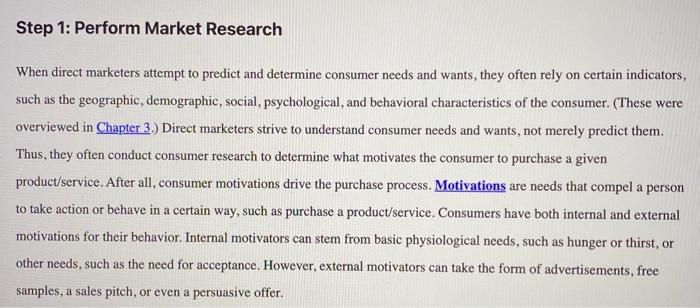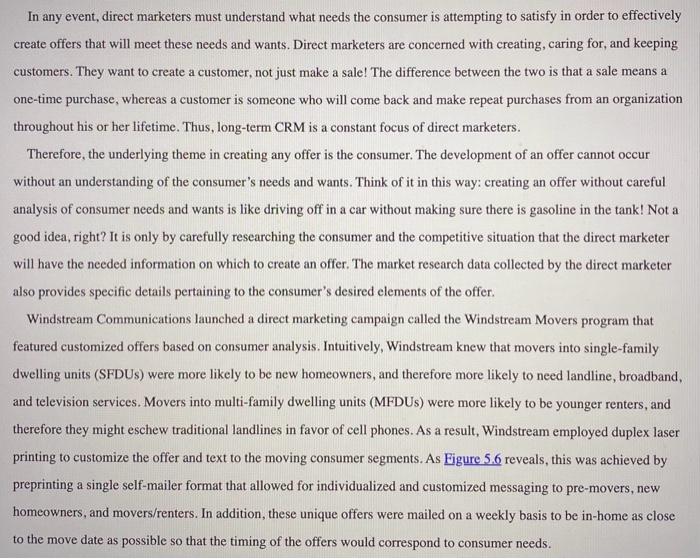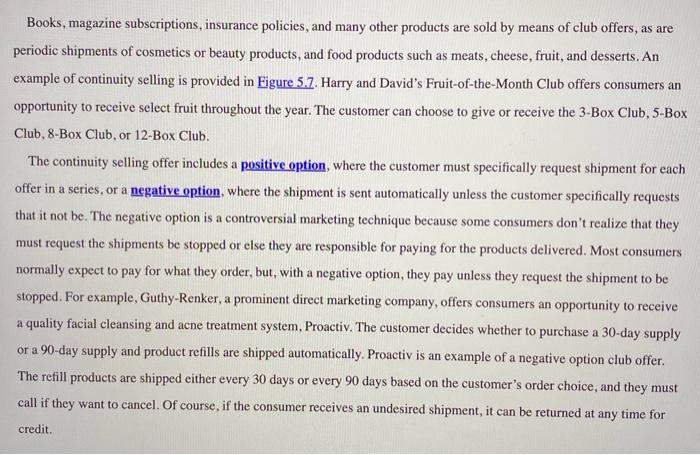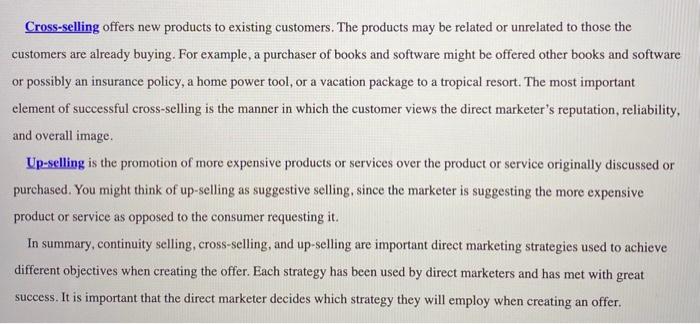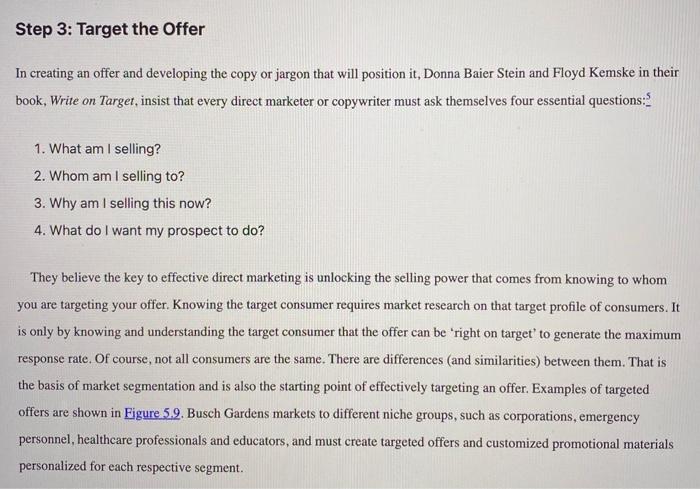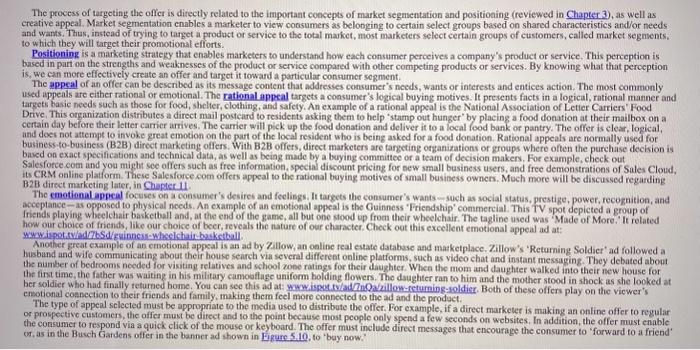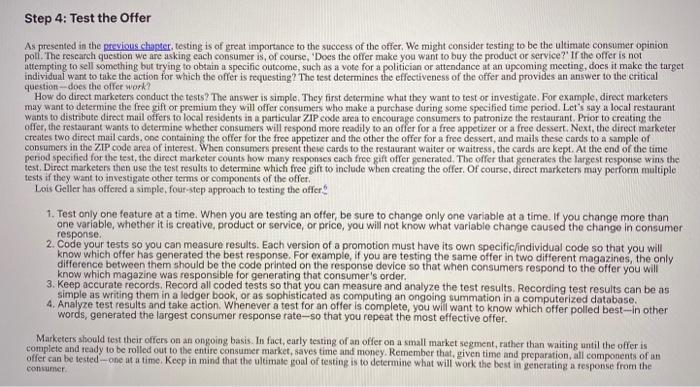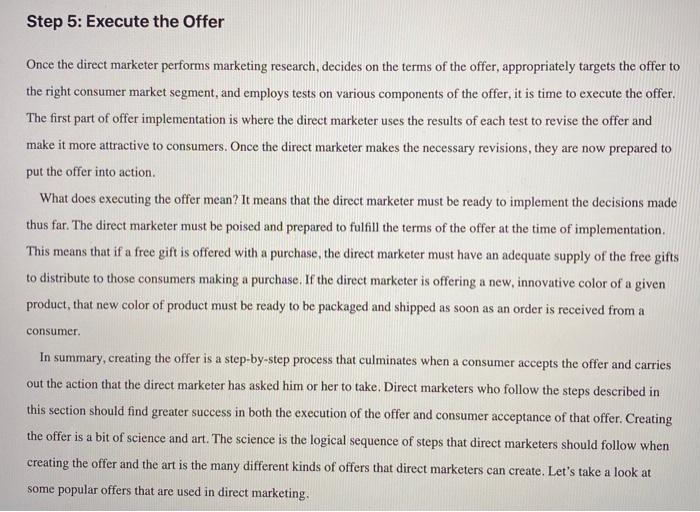1. Describe the five-step process to planning an offer. Is the order of this process important? Why or why not?
Step 1: Perform Market Research When direct marketers attempt to predict and determine consumer needs and wants, they often rely on certain indicators, such as the geographic, demographic, social, psychological, and behavioral characteristics of the consumer. (These were overviewed in Chapter 3.) Direct marketers strive to understand consumer needs and wants, not merely predict them. Thus, they often conduct consumer research to determine what motivates the consumer to purchase a given product/service. After all, consumer motivations drive the purchase process. Motivations are needs that compel a person to take action or behave in a certain way, such as purchase a product/service. Consumers have both internal and external motivations for their behavior. Internal motivators can stem from basic physiological needs, such as hunger or thirst, or other needs, such as the need for acceptance. However, external motivators can take the form of advertisements, free samples, a sales pitch, or even a persuasive offer. In any event, direct marketers must understand what needs the consumer is attempting to satisfy in order to effectively create offers that will meet these needs and wants. Direct marketers are concerned with creating, caring for, and keeping customers. They want to create a customer, not just make a sale! The difference between the two is that a sale means a one-time purchase, whereas a customer is someone who will come back and make repeat purchases from an organization throughout his or her lifetime. Thus, long-term CRM is a constant focus of direct marketers. Therefore, the underlying theme in creating any offer is the consumer. The development of an offer cannot occur without an understanding of the consumer's needs and wants. Think of it in this way: creating an offer without careful analysis of consumer needs and wants is like driving off in a car without making sure there is gasoline in the tank! Not a good idea, right? It is only by carefully researching the consumer and the competitive situation that the direct marketer will have the needed information on which to create an offer. The market research data collected by the direct marketer also provides specific details pertaining to the consumer's desired elements of the offer. Windstream Communications launched a direct marketing campaign called the Windstream Movers program that featured customized offers based on consumer analysis. Intuitively, Windstream knew that movers into single-family dwelling units (SFDUs) were more likely to be new homeowners, and therefore more likely to need landline, broadband, and television services. Movers into multi-family dwelling units (MFDUs) were more likely to be younger renters, and therefore they might eschew traditional landlines in favor of cell phones. As a result, Windstream employed duplex laser printing to customize the offer and text to the moving consumer segments. As Figure 5.6 reveals, this was achieved by preprinting a single self-mailer format that allowed for individualized and customized messaging to pre-movers, new homeowners, and movers/renters. In addition, these unique offers were mailed on a weekly basis to be in-home as close to the move date as possible so that the timing of the offers would correspond to consumer needs. What is the offer designed to do? Get orders? Generate sales leads? Sell subscriptions? Encourage repeat purchases or renewals? Introduce and sell new products? Increase the amount that the customer is presently purchasing? Raise funds? Without clearly established objectives, you won't be able to measure the success or failure of the offer-and remember that measurement is imperative in direct marketing. The underlying objective of any offer is to maximize profitability for a company or organization. Two of the most common methods of achieving increased profitability are (1) encouraging repeat purchases from existing customers, and (2) encouraging a company's current customers to purchase additional related or unrelated products beyond what they normally buy. The three direct marketing strategies that achieve this profit-maximization objective are continuity selling, cross-selling, and up-selling. Let's take a look at each of these strategies in turn. Continuity selling describes offers that are continued on a regular basis, whether weekly, monthly, quarterly, or annually. These offers are also called 'club offers' and are a hallmark of direct marketers who want to acquire customers who will remain active for an extended period of time. In continuity selling, customers buy related products or services as a series of small purchases, rather than all at a single time. Books, magazine subscriptions, insurance policies, and many other products are sold by means of club offers, as are periodic shipments of cosmetics or beauty products, and food products such as meats, cheese, fruit, and desserts. An example of continuity selling is provided in Figure 5.7. Harry and David's Fruit-of-the-Month Club offers consumers an opportunity to receive select fruit throughout the year. The customer can choose to give or receive the 3-Box Club, 5-Box Club, 8-Box Club, or 12-Box Club. The continuity selling offer includes a positive option, where the customer must specifically request shipment for each offer in a series, or a negative option, where the shipment is sent automatically unless the customer specifically requests that it not be. The negative option is a controversial marketing technique because some consumers don't realize that they must request the shipments be stopped or else they are responsible for paying for the products delivered. Most consumers normally expect to pay for what they order, but, with a negative option, they pay unless they request the shipment to be stopped. For example, Guthy-Renker, a prominent direct marketing company, offers consumers an opportunity to receive a quality facial cleansing and acne treatment system, Proactiv. The customer decides whether to purchase a 30-day supply or a 90-day supply and product refills are shipped automatically. Proactiv is an example of a negative option club offer. The refill products are shipped either every 30 days or every 90 days based on the customer's order choice, and they must call if they want to cancel. Of course, if the consumer receives an undesired shipment, it can be returned at any time for credit. Another example of a negative option offer is a til-forbid. A til-forbid (TF), is an offer that prearranges continuing shipments on a specified basis and is renewed automatically until the customer instructs otherwise. TF offers are commonly used with insurance policies or magazine subscriptions. Other examples include some clubs, such as book clubs, wine clubs, and automobile clubs, which may also include specific services with an annual membership fee. An example of a til-forbid offer is that of the Wine Club of the Williamsburg Winery, featured in Figure 5.8. The Winery offers three tiers of membership: the Classics Club, the Discovery Club, and the Connoisseurs Club, designed to meet all budgets and levels of interest. Depending on the level of membership, club members receive varying quantities of unique bottles of wine hand-selected by the Williamsburg Winery winemaker, along with varying discounts on all vintages and merchandise in the Williamsburg Winery retail shop and online wine shop. Once a customer signs up, membership in the wine club is ongoing, with the customer's credit card billed automatically each quarter. After two shipments of wine, members may cancel their membership by calling the Direct Shipping department at the Williamsburg Winery or by writing the Wine Club Director an e-mail requesting cancellation. Cancellation must be done at least 30 days in advance of the next billing cycle. Cross-selling offers new products to existing customers. The products may be related or unrelated to those the customers are already buying. For example, a purchaser of books and software might be offered other books and software or possibly an insurance policy, a home power tool, or a vacation package to a tropical resort. The most important element of successful cross-selling is the manner in which the customer views the direct marketer's reputation, reliability, and overall image. Up-selling is the promotion of more expensive products or services over the product or service originally discussed or purchased. You might think of up-selling as suggestive selling, since the marketer is suggesting the more expensive product or service as opposed to the consumer requesting it. In summary, continuity selling, cross-selling, and up-selling are important direct marketing strategies used to achieve different objectives when creating the offer. Each strategy has been used by direct marketers and has met with great success. It is important that the direct marketer decides which strategy they will employ when creating an offer. Step 3: Target the Offer In creating an offer and developing the copy or jargon that will position it, Donna Baier Stein and Floyd Kemske in their book, Write on Target, insist that every direct marketer or copywriter must ask themselves four essential questions:- 1. What am I selling? 2. Whom am I selling to? 3. Why am I selling this now? 4. What do I want my prospect to do? They believe the key to effective direct marketing is unlocking the selling power that comes from knowing to whom you are targeting your offer. Knowing the target consumer requires market research on that target profile of consumers. It is only by knowing and understanding the target consumer that the offer can be 'right on target' to generate the maximum response rate. Of course, not all consumers are the same. There are differences (and similarities) between them. That is the basis of market segmentation and is also the starting point of effectively targeting an offer. Examples of targeted offers are shown in Figure 5.9. Busch Gardens markets to different niche groups, such as corporations, emergency personnel, healthcare professionals and educators, and must create targeted offers and customized promotional materials personalized for each respective segment. The process of targeting the offer is directly related to the important concepts of market segmentation and positioaing (reviewed in Chapter 3), as well as creative appeal. Market segmentation enables a marketer to view consumers as belonging to certain select groups based on shared characteristics and/or needs and wants. Thus, instead of trying to target a product or service to the total mavket, most marketers select certain groups of customers, called market segnents. to which they will target their promotional efforts. Positioning is a marketing strategy that enables marketers to understand how each consumer perceives a company's product or service. This perception is based in part on the strengths and weaknesses of the product or service compared with other competing products or services. By knowing what that pereeption is. we ean more effectively create an offer and target it toward a particular consumer segnent. The appeal of an offer can be described as its message content that addresses consumet's needs, wants or interests and entices action. The most commonly used appeals are either rational or emotional. The rational appeal targets a consumer's logical buying motives. It presents facts in a logical, rational manner and targets basic needs such as those for food, shelier, clothing, and safety. An example of a rational appeal is the National Association of Letter Carriers' Food Drve. This organization distributes a direct mail pocteard to residents askiag them to help 'stamp out hunger' by placing a food donation at their mailbox on a certain day before their letter carrice arrives. The carrier will pick up the food donation and deliver it to a local food bank or pantry. The offer is clear, logical. and does not attempt to invoke great emotion on the part of the local resident who is being asked for a food donation. Rational appeals are normally used for business to-business (B2B) direct marketing offers. With B2B offers, difect marketers are fargeting organizations of groups where often the purchase decision is baked on exact specifications and technical data, as well as being made by a buying committec of a team of decision makers. For example, check out Salesforce com and you might see offers such as free information, special discount pricing for new small business users, and free demonstrations of Sales Cloud, its CRM online platorm. These Salesforce com offers appeal to the rational buying motives of small business owners. Moch more will be discussed regarding B2B direct marketing later, in Chapter 11. The emotional appeal focuses on a consumer's desires and feelisgs. It targets the consumer's wants- such as social status, prestige, power, recognition, and acceptance - as opposed to physical needs. An example of an enotional appeal is the Guinness 'Fricndship' commercial. This 'TV spot depicted a group of Iricnds playing wheelchair basketball and, at the end of the game, all but one stood op from their wheelchair. The tagline used was 'Made of More.' It related how our choice of friends, like our choice of beer, reveals the nature of our character. Check out this excellent emotional appeal ad at: Another great example of an emotional appeal is an ad by Zillow, an oaline real estate database and marketplace. Zillow's 'Returning Soldier' ad followed a busband and wife communicating about their house search via several different online platforms, such as video chat and instant messaging. They debated about the number of bedrooms needed for visiting relatives and school pobe ratings for their daughter. When the mom and daughter walked into their new house for the first time, the father was waiting in his military camooflage uniform bolding fowers. The daughter ran to him and the mother stood in shock as she looked at enotional cosnection to their friends and family, making them feel more connectod to the ad and the product. The type of appeal selected must be appropriate to the media used to distribute the offer. For example, if a direct marketer is making an online offer to regular or prospective customers, the offer must be direct and to the point because most people only spend a few seconds on websites, In addition, the offer must enable the consumer to respond via a quick click of the mouse or keyboard. The offer must include direct messages that encourage the consumer to 'forward to a friend' Or, as in the Busch Gandens offer in the banner ad shown in Figune 5.10 , to 'buy now." As presented in the previouschaper, testing is of great importance to the success of the offer. We might consider testing to be the ultimate consumer opinion poll. The research question we are asking each consumer is, of course, 'Does the offer make you want to buy the product or service?' If the offer is not attempting to sell something but trying to obtain a specific outcome, such as a vote for a politician or attendance at an upcoming meeting, does it make the target individual want to take the action for which the offer is fequesting? The fest determines the effectiveness of the offer and provides an answer to the critical question - does the offer work? How do direct marketers conduct the tests? The answer is simple. They first determine what they want to test or investigate. For example, direct marketers may want to determine the free gift or premium they will offer consumers who make a purchase during some specified time period. Let 's say a local restaurant wants to distribute direct mal offers to local residents in a particular ZIP code area to encourage consumers to patronize the restaturant. Prior to creating the offer, the restanrant wants to determine whether consumers will respond more readily to an offer for a free appetizer or a free dessert. Next, the direct marketer. creates two direet mail curds, one containing the offer for the froe appetizer and the other the offer for a free dessert, and mails these cards to a sample of consumers in the ZIP code area of interest. When consumers present theie cards to the restaurant waiter or waitress, the cards are kept. At the end of the time period specified for the test, the direct marketer counts how many responses each free gift offer generated. The offer that generates the largest response wins the test. Direct marketers then use the test results to determine which free gift to include wben creating the offer. Of course, direct marketers may perform multiple tests if they want to investigate other terms or components of the offer. Lois Geller has offered a simple, four-step approach to testing the offer? 1. Test only one feature at a time. When you are testing an offer, be sure to change only one variable at a time. If you change more than one variable, whether it is creative, product or service, or price, you will not know what variable change caused the change in consumer response. 2. Code your tests so you can measure results. Each version of a promotion must have its own specificfindividual code so that you will know which offer has generated the best response. For example, if you are testing the same offer in two different magazines, the only difference between them should be the code printed on the response device so that when consumers respond to the offer you will know which magazine was responsible for generating that consumer's order. 3. Keep accurate records, Record all coded tests so that you can measure and analyze the test results. Recording test results can be as simple as writing them in a ledger book, or as sophisticated as computing an ongoing summation in a computerized database. 4. Analyze test results and take action. Whenever a test for an offer is complete, you will want to know which offer polled best-in other words, generated the largest consumer response rate-so that you repeat the most effective offer. Marketers sbould test their offers oa an ongoing basis. In fact, early testing of an offer on a small market segment, rather than waiting until the offer is complete and ready to be rolled out to the entire consunser market, saves time and money. Remember that, given time and preparation, all components of an offer can be tested-one at a time. Keep in mind that the ultimale goal of testing is to determine what will work the best in generating a response from the consunter. Once the direct marketer performs marketing research, decides on the terms of the offer, appropriately targets the offer to the right consumer market segment, and employs tests on various components of the offer, it is time to execute the offer. The first part of offer implementation is where the direct marketer uses the results of each test to revise the offer and make it more attractive to consumers. Once the direct marketer makes the necessary revisions, they are now prepared to put the offer into action. What does executing the offer mean? It means that the direct marketer must be ready to implement the decisions made thus far. The direct marketer must be poised and prepared to fulfill the terms of the offer at the time of implementation. This means that if a free gift is offered with a purchase, the direct marketer must have an adequate supply of the free gifts to distribute to those consumers making a purchase. If the direct marketer is offering a new, innovative color of a given product, that new color of product must be ready to be packaged and shipped as soon as an order is received from a consumer. In summary, creating the offer is a step-by-step process that culminates when a consumer accepts the offer and carries out the action that the direct marketer has asked him or her to take. Direct marketers who follow the steps described in this section should find greater success in both the execution of the offer and consumer acceptance of that offer. Creating the offer is a bit of science and art. The science is the logical sequence of steps that direct marketers should follow when creating the offer and the art is the many different kinds of offers that direct marketers can create. Let's take a look at some popular offers that are used in direct marketing
